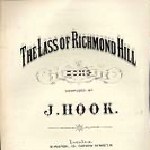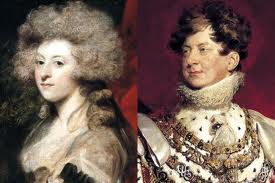Annotation:Lass of Richmond Hill (The)
X:1 T:The Lass of Richmond Hill M:2/4 L:1/8 K:F c|cfff|g/f/e/f/ gb|afdg|f2 ec| cfff|g/f/e/f/ gf|ecd=B|(c2 c):| |:f|eccf|eccf|egba|a2 gf| eccf|ecc'f|efge|(f2 f):|]

LASS OF RICHMOND HILL, THE. AKA – "Sweet Lass of Richmond Hill." AKA and see "British Grenadiers (2) (The)," "Richmond Hill (1)," "Rushy Mountain (The)." English, Scottish; Country Dance Tune. F Major (Raven): D Major (Ashman, Kerr, Sumner): A Mixolydian (Ross). Standard tuning (fiddle). One part (Ashman): AABB (Raven, Ross): AABCC (Kerr, Sumner). Once a very popular song written by Leonard McNally (1752–1820) in honor of Frances l'Anson, born in Leyburn, Wensleydale, Yorkshire, in 1766. She was associated with Hill House, Richmond, through her maternal grandparents who had occupied the house from 1750–1768, and was the daughter of William L'Anson, a wealthy attorney of Bedford Row, London, and later of Hill House, Richmond, Yorkshire. McNally was an eloquent Irish lawyer who was involved in the political affairs of the time and who dabbled in the arts, writing several plays and some poetry. It has been said he wrote the poem in as part of a campaign to woo Frances into a marriage against the wishes of her family, and if so, he was successful for they wed in 1767. McNally's poem was set to music by composer wikipedia:James_Hook_(composer) (1746–1827), the organist at Vauxhall Gardens, and was first sung there in 1789 by Charles Benjamin Incleson, a famous tenor of the era. The song was published a year later, and became popular not only in England but America as well. Unfortunately, Frances died at the young age of 29 in Dublin, leaving a young son. McNally later remarried.
On Richmond Hill there lives a lass
More bright than May-day morn
Whose charms all other maids' surpass
A rose without a thorn.
This lass so neat, with smiles so sweet
Has won my right good will
I'd crowns resign to call thee mine
Sweet lass of Richmond Hill.
Sweet lass of Richmond Hill
Sweet lass of Richmond Hill
I'd crowns resign to call thee mine
Sweet lass of Richmond Hill.
Ye zephyrs gay that fan the air
And wanton thro' the grove
O whisper to my charming fair
"I die for her I love."
This lass so neat, with smiles so sweet
Has won my right good will
I'd crowns resign to call thee mine
Sweet lass of Richmond Hill.
Sweet lass of Richmond Hill
Sweet lass of Richmond Hill
I'd crowns resign to call thee mine
Sweet lass of Richmond Hill.
Despite his famously expressed passion for his "Sweet Lass," there was unfortunately a darker side to McNally. He became a member of the United Irishmen and, as a lawyer was called on to defend many of their members in court. His clients, however, were invariably convicted, and after his death it was discovered that he had been in the pay of the British government. It was he who betrayed Lord Edward Fitzgerald (1798) and Robert Emmet (1803).
The music of "The Lass of Richmond Hill" sometimes has been attributed to the Prince of Wales, later George IV, written it is said for Maria Fitzherbert (1756–1837). Mrs. Fitzherbert, born Smythe, was a young woman twice widowed when the Prince met her in 1784—he was only 22 years of age, and she about six years older—and fell deeply in love with her. Independently wealthy, she had lived since 1782 at Richmond, Surrey, having at the same time a house in London. She was a celebrated beauty of whom Lord Strouton wrote:

I'd crowns resign to call her mine,
Sweet lass of Richmond Hill.
Barred from legally marrying him, she at first sought to discourage the Prince, even to the point of moving to the Continent for a time, but three years later in a discrete private ceremony they were wed. They could not live openly together, however, and there followed years of a relationship carried on in separate dwellings (it should be noted that the Prince was a notorious philanderer). Finally, in 1794, the Prince was reluctantly constrained to deny Mrs. Fitzherbert and marry his cousin, Caroline of Brunswick, with whom he stayed only until the birth of their daughter in 1796. Hating the Princess of Wales, he separated from her and sought out Mrs. Fitzherbert again and in 1800 persuaded her to return to him, which she did for another nine years. Their affair ended when the Prince became regent in 1811. A celebration had been arranged at Carleton House by the Prince, which she attended only to find that no fixed place at the royal table had been assigned to her. Affronted, she broke of relations with him and withdrew into private life. The Prince, finally King George IV, died in 1830 and was found to have a locket containing her miniature around his neck, with which he was buried. She outlived him by seven years and died in Brighton.
Richmond Hill is a gentle slope, then near London (now absorbed), that offered a beautiful view of the River Thames. It was considered special enough that an act of Parliament was passed in 1902 (the "Richmond, Ham, and Petersham Open Spaces Act) protecting it. The future city of Richmond, Virginia, was named because its hilltop location afforded a similar view of the James River.
The melody "Lass of Richmond Hill" has fairly recently been adopted by morris dance musicians for a number of dances, and a dance called the Lass of Richmond Hill was composed circa 1970 by Martin Johnson of Hammersmith Morris. Latter 19th century County Leitrim musician Stephen Grier entered a version of the tune in his c. 1883 music manuscript collection as "British Grenadiers (2) (The)." See also Francis O'Neill's Irish variant under the title "Rushy Mountain (The)."

